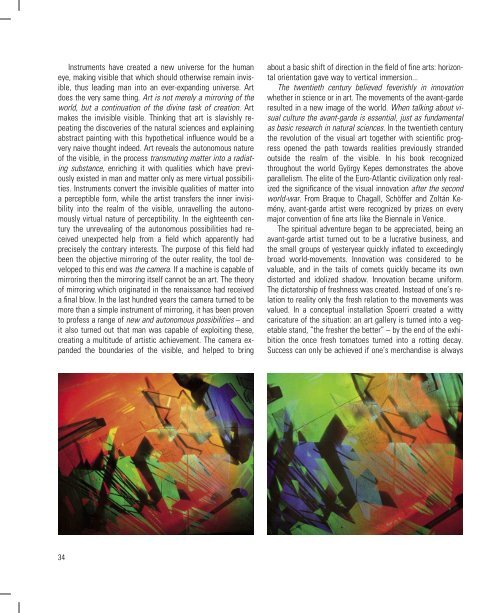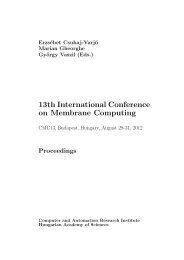Time on the Tilt
Time on the Tilt
Time on the Tilt
You also want an ePaper? Increase the reach of your titles
YUMPU automatically turns print PDFs into web optimized ePapers that Google loves.
Instruments have created a new universe for <strong>the</strong> human<br />
eye, making visible that which should o<strong>the</strong>rwise remain invisible,<br />
thus leading man into an ever-expanding universe. Art<br />
does <strong>the</strong> very same thing. Art is not merely a mirroring of <strong>the</strong><br />
world, but a c<strong>on</strong>tinuati<strong>on</strong> of <strong>the</strong> divine task of creati<strong>on</strong>. Art<br />
makes <strong>the</strong> invisible visible. Thinking that art is slavishly repeating<br />
<strong>the</strong> discoveries of <strong>the</strong> natural sciences and explaining<br />
abstract painting with this hypo<strong>the</strong>tical influence would be a<br />
very naive thought indeed. Art reveals <strong>the</strong> aut<strong>on</strong>omous nature<br />
of <strong>the</strong> visible, in <strong>the</strong> process transmuting matter into a radiating<br />
substance, enriching it with qualities which have previously<br />
existed in man and matter <strong>on</strong>ly as mere virtual possibilities.<br />
Instruments c<strong>on</strong>vert <strong>the</strong> invisible qualities of matter into<br />
a perceptible form, while <strong>the</strong> artist transfers <strong>the</strong> inner invisibility<br />
into <strong>the</strong> realm of <strong>the</strong> visible, unravelling <strong>the</strong> aut<strong>on</strong>omously<br />
virtual nature of perceptibility. In <strong>the</strong> eighteenth century<br />
<strong>the</strong> unrevealing of <strong>the</strong> aut<strong>on</strong>omous possibilities had received<br />
unexpected help from a field which apparently had<br />
precisely <strong>the</strong> c<strong>on</strong>trary interests. The purpose of this field had<br />
been <strong>the</strong> objective mirroring of <strong>the</strong> outer reality, <strong>the</strong> tool developed<br />
to this end was <strong>the</strong> camera. If a machine is capable of<br />
mirroring <strong>the</strong>n <strong>the</strong> mirroring itself cannot be an art. The <strong>the</strong>ory<br />
of mirroring which originated in <strong>the</strong> renaissance had received<br />
a final blow. In <strong>the</strong> last hundred years <strong>the</strong> camera turned to be<br />
more than a simple instrument of mirroring, it has been proven<br />
to profess a range of new and aut<strong>on</strong>omous possibilities – and<br />
it also turned out that man was capable of exploiting <strong>the</strong>se,<br />
creating a multitude of artistic achievement. The camera expanded<br />
<strong>the</strong> boundaries of <strong>the</strong> visible, and helped to bring<br />
about a basic shift of directi<strong>on</strong> in <strong>the</strong> field of fine arts: horiz<strong>on</strong>tal<br />
orientati<strong>on</strong> gave way to vertical immersi<strong>on</strong>...<br />
The twentieth century believed feverishly in innovati<strong>on</strong><br />
whe<strong>the</strong>r in science or in art. The movements of <strong>the</strong> avant-garde<br />
resulted in a new image of <strong>the</strong> world. When talking about visual<br />
culture <strong>the</strong> avant-garde is essential, just as fundamental<br />
as basic research in natural sciences. In <strong>the</strong> twentieth century<br />
<strong>the</strong> revoluti<strong>on</strong> of <strong>the</strong> visual art toge<strong>the</strong>r with scientific progress<br />
opened <strong>the</strong> path towards realities previously stranded<br />
outside <strong>the</strong> realm of <strong>the</strong> visible. In his book recognized<br />
throughout <strong>the</strong> world György Kepes dem<strong>on</strong>strates <strong>the</strong> above<br />
parallelism. The elite of <strong>the</strong> Euro-Atlantic civilizati<strong>on</strong> <strong>on</strong>ly realized<br />
<strong>the</strong> significance of <strong>the</strong> visual innovati<strong>on</strong> after <strong>the</strong> sec<strong>on</strong>d<br />
world-war. From Braque to Chagall, Schöffer and Zoltán Kemény,<br />
avant-garde artist were recognized by prizes <strong>on</strong> every<br />
major c<strong>on</strong>venti<strong>on</strong> of fine arts like <strong>the</strong> Biennale in Venice.<br />
The spiritual adventure began to be appreciated, being an<br />
avant-garde artist turned out to be a lucrative business, and<br />
<strong>the</strong> small groups of yesteryear quickly inflated to exceedingly<br />
broad world-movements. Innovati<strong>on</strong> was c<strong>on</strong>sidered to be<br />
valuable, and in <strong>the</strong> tails of comets quickly became its own<br />
distorted and idolized shadow. Innovati<strong>on</strong> became uniform.<br />
The dictatorship of freshness was created. Instead of <strong>on</strong>e’s relati<strong>on</strong><br />
to reality <strong>on</strong>ly <strong>the</strong> fresh relati<strong>on</strong> to <strong>the</strong> movements was<br />
valued. In a c<strong>on</strong>ceptual installati<strong>on</strong> Spoerri created a witty<br />
caricature of <strong>the</strong> situati<strong>on</strong>: an art gallery is turned into a vegetable<br />
stand, “<strong>the</strong> fresher <strong>the</strong> better” – by <strong>the</strong> end of <strong>the</strong> exhibiti<strong>on</strong><br />
<strong>the</strong> <strong>on</strong>ce fresh tomatoes turned into a rotting decay.<br />
Success can <strong>on</strong>ly be achieved if <strong>on</strong>e’s merchandise is always<br />
fresh. These expectati<strong>on</strong>s have turned many an exhibiti<strong>on</strong> into<br />
a shallow affair. During <strong>the</strong> sec<strong>on</strong>d half of <strong>the</strong> twentieth century<br />
<strong>the</strong>re have been entire decades when all major exhibiti<strong>on</strong>s<br />
in Western Europe and <strong>the</strong> United States displayed nothing<br />
else but art c<strong>on</strong>sidered fresh at that time. When POP ART<br />
or MINIMAL ART were <strong>the</strong> height of fashi<strong>on</strong> you could see<br />
nothing but POP ART or MINIMAL ART. The momentum of <strong>the</strong><br />
avant-garde had abated. The inevitable counter-reacti<strong>on</strong> was<br />
imminent. Everybody began to speak about <strong>the</strong> death of <strong>the</strong><br />
avant-garde, dubbing it a collective madness, a deadly illusi<strong>on</strong><br />
and a totalitarian ideology. As Albrecht Welmer formulated it:<br />
“no benevolent ideology has been buried with such imminent<br />
hatred.” We should not look for <strong>the</strong> source of this hatred, but<br />
we must remain objective and value oriented, and we must<br />
not forget that <strong>the</strong> avant-garde movement had undoubtedly<br />
possessed both momentum and ingenuity. This ingenuity must<br />
be retained even after <strong>the</strong> avant-garde, tough it is questi<strong>on</strong>able<br />
whe<strong>the</strong>r <strong>the</strong> real sense of <strong>the</strong> world avant-garde can be<br />
left behind at all.<br />
We c<strong>on</strong>tinuously keep modelling <strong>the</strong> world. We build and<br />
rebuild it, knowing that here is no final soluti<strong>on</strong>. This is not <strong>the</strong><br />
acceptance of <strong>the</strong> impossibility, but a paradox loyalty: <strong>the</strong> loyalty<br />
of an inquisitive mind to its own principles and also an<br />
acknowledgment of <strong>the</strong> finality of human nature. This practice<br />
however spans into <strong>the</strong> infinite, because it carries <strong>the</strong> basic<br />
principle of spiritual work: creati<strong>on</strong>. This practice, working into<br />
<strong>the</strong> transformati<strong>on</strong> of c<strong>on</strong>sciousness into something present<br />
fur<strong>the</strong>rs <strong>the</strong> creati<strong>on</strong> of reality. The art of light originates from<br />
<strong>the</strong> avant-garde. Its twentieth century predecessor were <strong>the</strong><br />
A transmissi<strong>on</strong> hologram dissolving across fields<br />
leading artists of <strong>the</strong> avant-garde. László Moholy Nagy in his<br />
writings and with his modulators of light and space created<br />
<strong>the</strong> fundaments in <strong>the</strong> Bauhaus movement. What he said<br />
about <strong>the</strong> tasks of <strong>the</strong> light-painters of <strong>the</strong> future is now comm<strong>on</strong><br />
knowledge. The intimate relati<strong>on</strong>ship fine art has to<br />
achieve with <strong>the</strong> bright radiati<strong>on</strong> of light, with <strong>the</strong> interference,<br />
<strong>the</strong> prisms, lenses and various o<strong>the</strong>r optical devices, has<br />
in <strong>the</strong> last few years became an especially timely issue, as we<br />
are currently witnessing an opto-electr<strong>on</strong>ical revoluti<strong>on</strong> multiplying<br />
its possibilities. These possibilities do not enfold <strong>on</strong><br />
<strong>the</strong>ir own. The cooperati<strong>on</strong> of artists, scientists and engineers<br />
is needed. György Kepes formulated <strong>the</strong> above need, and in<br />
<strong>the</strong> MIT in Cambridge he created <strong>the</strong> CAVS <strong>the</strong> first institute<br />
of <strong>the</strong> world serving <strong>the</strong> purpose of this cooperati<strong>on</strong>.<br />
The boundaries of <strong>the</strong> visual arts are dissolving, photographers<br />
rely <strong>on</strong> methods utilized by <strong>the</strong> fine arts and <strong>the</strong> reverse<br />
is also true. The machine has become part of <strong>the</strong> work of art,<br />
34 35
















